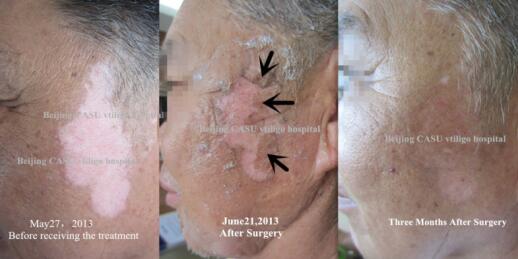Autologous Epidermal Grafting Therapy for Vitiligo
 1.What is autologous epidermal grafting therapy for vitiligo treatment?
1.What is autologous epidermal grafting therapy for vitiligo treatment?
It applies instruments vacuum aspiration principle to transplant skin epidermal layer at normal positions to white spots lesion positions, thus increasing melanophore quantities at lesion positions.
Suction blister transplantation means the skin be under -200 mmHg negative pressure effect, after 2~3 hours, epidermis and dermis will be separated and then generate to be blister. The activate melanophore inside blister will translate blister skin to white spots which have been frozen by liquid nitrogen or widen off by skin ablation. Then bind up and immobilize. After about 7 days, the surface of a wound will union. And pigment will spread to be consistent with surrounding skin color after 3-6 months’ treatment.
2. What is the specific content of autologous epidermal grafting therapy?
It usually applies multihole sucking disc to place at skin lesion positions and donor sites(usually choose abdomen and leg inner skin). At the same time, use 30~60 kpa negative pressure to attract blister to make epidermis and dermis separate. After the onset of blister, wipe off blister epidermis of white spots, and take donor sites blister epidermis to tile on white spots’ deepithelialization exposed surface. Put pressure and bind up to make normal skin grow on lesion positions. Use the melanin growth in normal skin to supplement melanin deficiency at lesion positions.
3. What kind of vitiligo is suitable for autologous epidermal grafting therapy?
Stable, segmental, and local type vitiligo, and stubborn vitiligo that can not achieve any effect using other treatments.
4. What is the donor sites of autologous epidermal grafting therapy?
At vitiligo positions, transplant 1~2 mm size normal skin. The donor sites usually at lumbosacral portion or leg end positions.
5. How is the effect of autologous epidermal grafting therapy?
According to data, stable and stubborn vitiligo patients have made good results by using this therapy. At the same time, PUVA before and after transplantation is quite necessary to improve effects. Many specialized hospital have applied this treatment, the successful rate is about 80%~90% or over 90%. And our hospital’s patients have achieved satisfied treatment effects.
6. How long it takes to see effect of transplanted epidermis?
Usually, it takes about 2 weeks for transplanted epidermis to survive, meaning pigment generation. After about 4 weeks, the melanin will enlarge. After 3-6 months, pigment will enlarge to high limit. The pigment area can increase to above 25 times of former area. However, this treatment has high demand for doctors and equipments. Skin graft, bind up and buffing are all important steps. In specialized vitiligo hospitals, the treatment cases are more. Doctors are more experienced and equipments are more advanced.
7. What should be payed attention to when doing autologous epidermal grafting therapy?
First, vitiligo is related to trauma. Patients who have isomorphic reaction and are in development stage are not allowed to use this therapy.
Second, at skin rough areas, the epidermis separation is difficult. So corresponding separator should be set high temperature and negative pressure.
Third, donor area usually are abdomen or inner thigh flat positions.
Forth, if vitiligo positions have hair, such as eyebrow and hair, should shave off hair first.
Fifth, in separator circular hole, if several small blisters have emerged to be big half full blister, it means the epidermis has been separated completely. And the separator can be taken off.
Sixth, when use grinding method, doctors should control depth strictly. According to dot ooze blood at the wound, if the depth is shallow, epidermis can not survive. If too deep, it will arouse scar.
Seventh, the operation should be strictly sterile to avoid infection. If there are blisters, should use 0.1% benzalkonium bromide to disinfect.
Eighth, activity and friction area should be fixed after surgery.
Ninth, the donor area and lesion position should be protected and avoid water within 7-10 days after surgery.
8. What is the side effect of autologous epidermal grafting therapy?
The advantage of this therapy is rapid effect, little trauma and satisfied effect. At the same time, it can not hurt dermis, and can not leave scar. But the equipments demands are strict. The surgery time is short, may cause the skin irregularity at lesion positions.
9. Is it the best therapy to treat vitiligo? Can it cure vitiligo thoroughly?
Although this method can get rapid effect, it is not suitable for most development stage vitiligo patients. And for vitiligo, any isolate treatment has big difficulty to cure vitiligo. Vitiligo is only a kind of skin disease, but it is related to inheritance, immunity(antibody, immunity function, interleukin), trace elements deficiency, metabolism(free radical), endocrine(thyroid) and various systems. Therefore, just rely on local treatment can not reach perfect treatment. From the perspective of traditional Chinese medicines, the onset of vitiligo has relation with external infection, Qi and blood, Yin and Yang, internal livers. Therefore, Beijing CASU vitiligo hospital UMD multidimensional diagnosis and treatment system suggests that integral assessment and diagnosis and treatment vitiligo is the advance of vitiligo treatment.
If you want a further knowledge about vitiligo causes, you can send your own problem to vitiligocure@hotmail.com and we will give you a professional solution. After all, the symptoms are similar, but the real conditions are different.To cure this illness,we need to find the authentic pathogenesis according to different conditions of different patients.



Leave a Comment